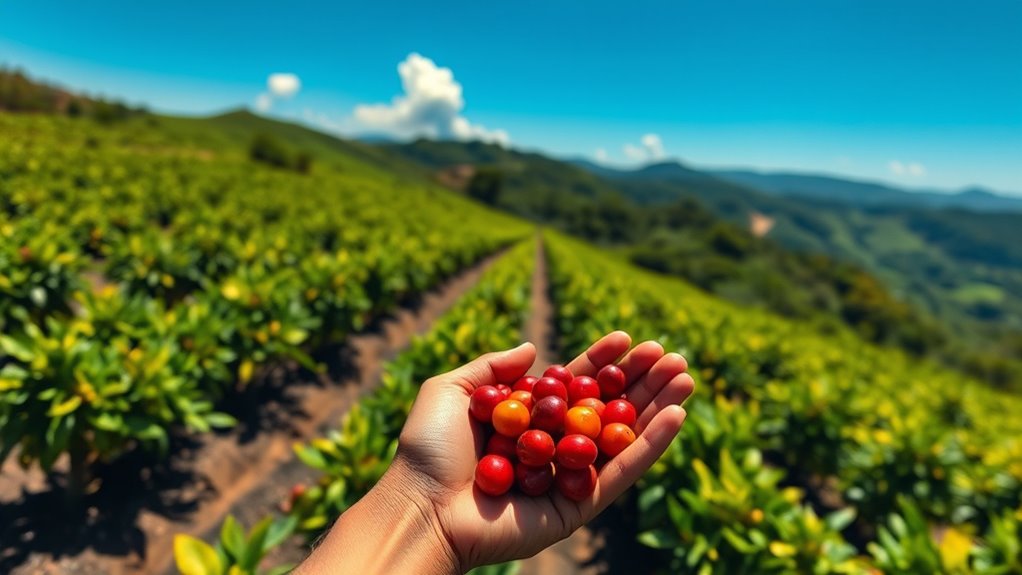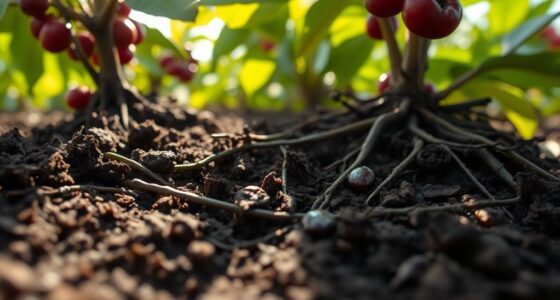Coffee production has a significant environmental impact, contributing to approximately 5% of global deforestation and biodiversity loss. Each cup leads to soil degradation and water pollution due to heavy fertilizer and pesticide use. Particularly, coffee farming generates a high carbon footprint, especially when compared to tea. Supporting sustainable practices, like choosing organic coffee and using reusable cups, can help mitigate these issues. Discovering more about these choices can enhance your coffee experience while protecting the planet.
Key Takeaways
- Coffee production contributes to 5% of global deforestation, significantly impacting biodiversity and ecosystems.
- Each cup of coffee results in the loss of approximately one square inch of rainforest.
- Heavy fertilizer and pesticide use leads to soil degradation, water pollution, and chemical runoff.
- Coffee farming generates 57% waste from coffee cherries, increasing carbon footprints and water consumption.
- Promoting sustainable practices, like organic and shade-grown coffee, helps mitigate environmental impacts.
The Environmental Impact of Coffee Production
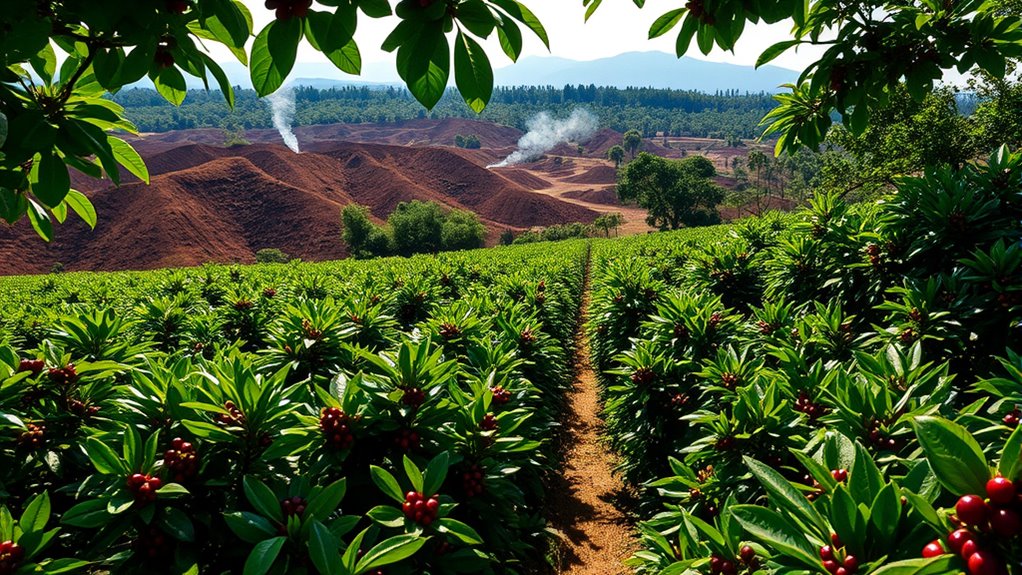
As you savor your morning cup of coffee, it’s essential to recognize the hidden environmental costs that come with it.
Coffee production has a significant environmental impact, contributing to about 5% of global deforestation and generating substantial greenhouse gas emissions. Each cup you enjoy results in the loss of roughly one square inch of rainforest.
Additionally, the heavy use of fertilizers and pesticides in coffee farming leads to soil degradation and water pollution, harming local ecosystems.
However, you can make a difference by choosing sustainable coffee options, like shade-grown varieties, which promote biodiversity and reduce chemical reliance.
Deforestation and Biodiversity Loss
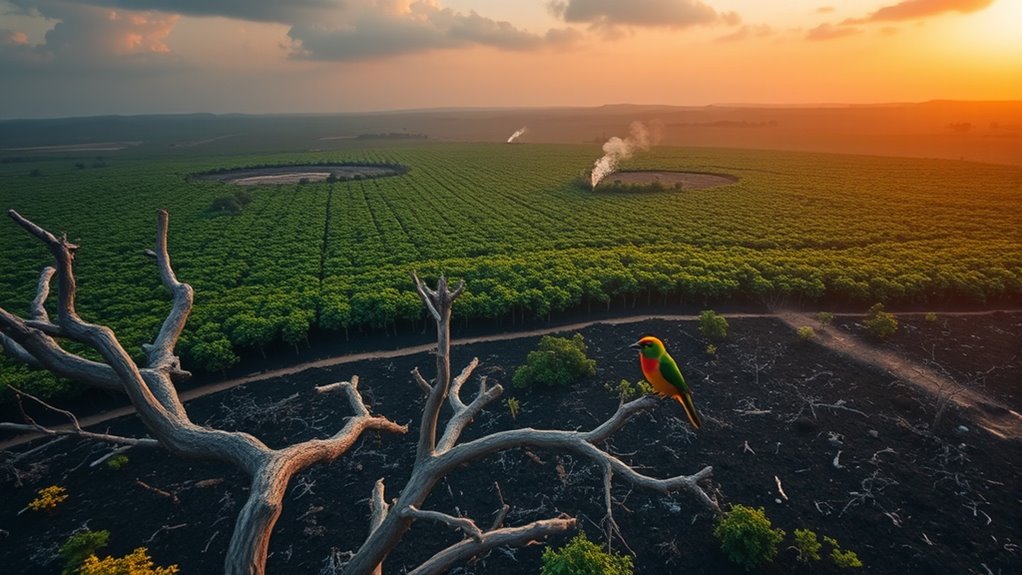
While you might enjoy your coffee, it’s essential to understand how its production contributes to deforestation and biodiversity loss.
Coffee plantations are responsible for about 5% of global deforestation, clearing vast forest areas, which drastically reduces rainforest coverage from 15% in the 1950s to just 6% today. Each cup of coffee you consume destroys about one square inch of rainforest, highlighting its direct impact.
This conversion not only leads to significant biodiversity loss, as many species lose their habitats, but also exacerbates climate change by reducing carbon sequestration.
The ongoing expansion of coffee farming poses a serious threat to ecosystems, making it vital to reflect on sustainable practices that protect our forests and the biodiversity they harbor.
Soil Erosion and Degradation
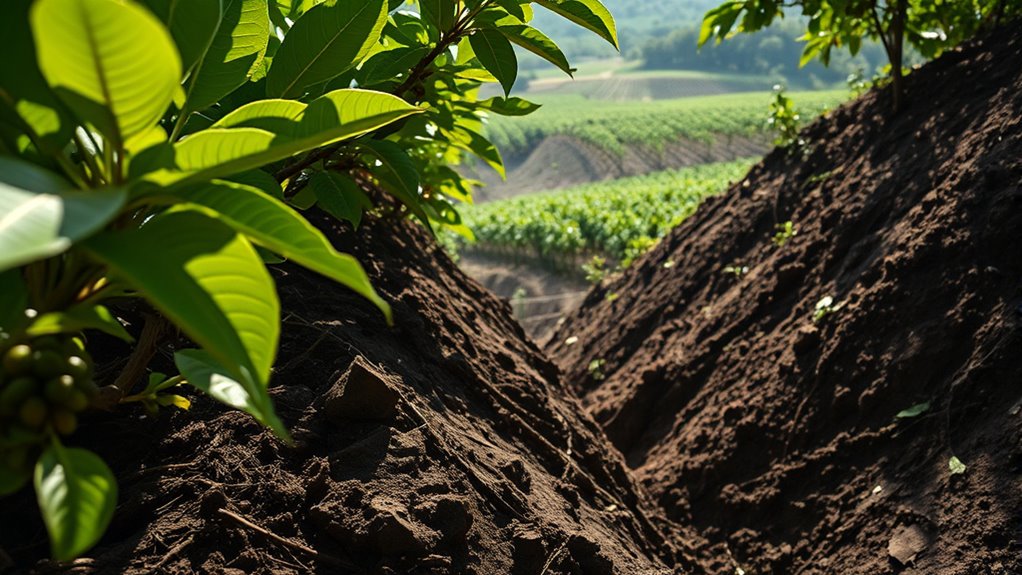
Coffee production greatly contributes to soil erosion and degradation, particularly as rainforests are converted into plantations. The rapid loss of organic soil components occurs within just five years, thanks to unsustainable agricultural practices like monocropping. This method depletes essential nutrients, leading to long-term soil degradation.
Deforestation associated with coffee farming exposes soil, making it vulnerable to wind and water erosion, which considerably impacts agricultural productivity. Additionally, the loss of tree cover disrupts natural water cycles, increasing runoff and further exacerbating soil erosion.
Protecting standing forests is crucial; it not only preserves biodiversity but also enhances soil health, promoting agricultural sustainability. You can help by supporting sustainable coffee practices that prioritize environmental preservation.
Water Pollution and Chemical Runoff
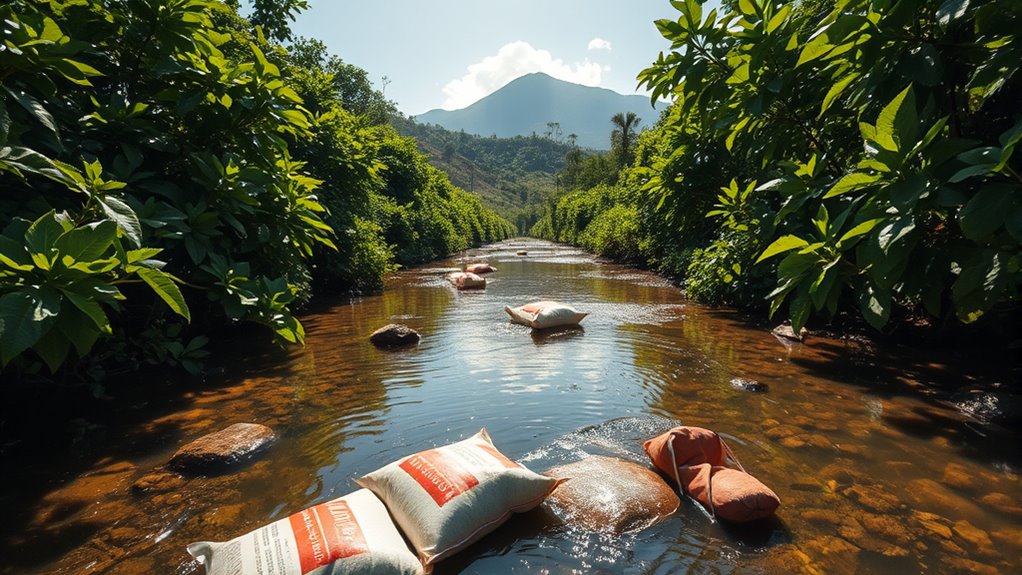
The use of fertilizers in coffee production greatly impacts water quality, as nitrates leach into surrounding water sources, harming aquatic ecosystems.
You mightn’t realize that the production process contributes considerably to water pollution through various means:
- Heavy pesticide use leads to chemical runoff, contaminating nearby waterways.
- Approximately 57% of the coffee cherry becomes waste, decomposing and depleting oxygen levels in water bodies.
- Ineffective enforcement of anti-dumping laws allows ongoing pollution from coffee production waste.
- The combination of fertilizer runoff and organic waste contributes to eutrophication, causing algal blooms that threaten aquatic biodiversity.
Together, these factors exacerbate the environmental impact on water resources, making it essential to address these issues in coffee farming practices.
Comparing Tea and Coffee Environmental Footprints
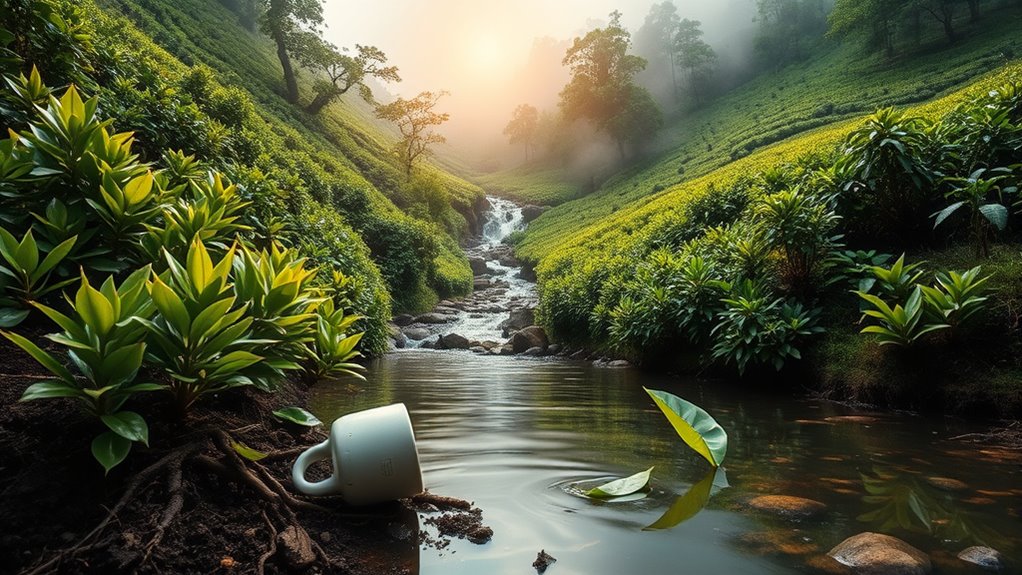
When you compare tea and coffee, you’ll notice that tea generally uses less water and creates less waste.
For instance, brewing a cup of coffee can require about 39 gallons of water, while tea needs much less.
Additionally, tea’s minimal packaging means it often generates less waste than coffee, which has a more complex supply chain contributing to its environmental footprint.
Water Consumption Comparison
While exploring the environmental impacts of popular beverages, you’ll find that coffee’s water consumption far exceeds that of tea. Producing just one cup of coffee requires about 39 gallons of water. In contrast, tea cultivation uses considerably less water, contributing to its lower environmental footprint.
Here are some key points to reflect on:
- Coffee farming practices like sun-grown plantations increase water usage.
- Shade-grown coffee promotes biodiversity and conserves water resources.
- The environmental impact of coffee includes higher water usage during cultivation and transportation.
- Loose-leaf tea generally results in less packaging waste and lower water consumption.
Waste Generation Differences
Although both coffee and tea are beloved beverages, their waste generation reveals stark differences in environmental impact.
Coffee production generates a staggering amount of waste, with 57% of coffee cherries discarded. This leads to a significant carbon footprint of coffee, compounded by the 50 billion non-recyclable coffee cups tossed in the U.S. each year.
In contrast, tea typically involves less processing and minimal packaging waste, especially when you choose loose-leaf options.
Additionally, water consumption for a single cup of coffee is about 39 gallons, far exceeding that of tea cultivation.
Energy Efficiency and Brewing Methods

When you choose your brewing method, you’re not just picking a flavor; you’re also impacting energy efficiency and waste.
For instance, using a plug-in kettle is much more energy-efficient than a microwave for boiling water.
Brewing Method Efficiency
As you consider your coffee brewing methods, you’ll find that efficiency plays an essential role in minimizing environmental impact.
Your choice of brewing can drastically affect energy consumption and the carbon footprint of your daily cup. Here are some tips for brewing more sustainably:
- Use plug-in kettles, which are 5 to 10 times more energy-efficient than microwaves.
- Opt for single-cup brewing systems to reduce waste and energy use.
- Choose black coffee or loose-leaf tea to keep your carbon footprint low at 21 grams CO2 per cup.
- Utilize compostable filters with ceramic holders for environmentally friendly disposal.
Additionally, being mindful of your brewing method can help reduce air quality concerns associated with traditional coffee preparation methods.
Waste Reduction Techniques
Waste reduction techniques are essential for minimizing the environmental impact of coffee production and consumption.
One effective approach is to avoid single-serve coffee options, which generate excessive packaging waste. Instead, brew a whole pot or use compostable coffee filters to enhance sustainability.
You can also repurpose used coffee grounds by adding them to your compost bin, returning valuable nutrients to the soil.
When enjoying your coffee, opt for reusable cup options instead of disposable ones, which often end up in landfills.
Additionally, consider using plug-in kettles for boiling water, as they’re 5 to 10 times more energy-efficient than microwaves. Understanding the mechanics of French press coffee brewing can also help minimize waste by ensuring you extract the best flavor from your grounds.
Energy Consumption Comparison
While you may not realize it, the brewing method you choose can considerably impact energy consumption in coffee preparation.
Different brewing methods can lead to varying carbon footprints and energy costs per cup. Here are some key points to contemplate:
- Plug-in kettles are 5 to 10 times more energy-efficient than microwaves for boiling water.
- Single-serve machines typically use more energy per cup compared to traditional drip coffee makers.
- Brewing a whole pot of drip coffee can lead to waste, increasing energy costs if not fully consumed.
- Using compostable filters with ceramic holders reduces waste and energy use compared to traditional filters.
Carbon Footprint Calculations
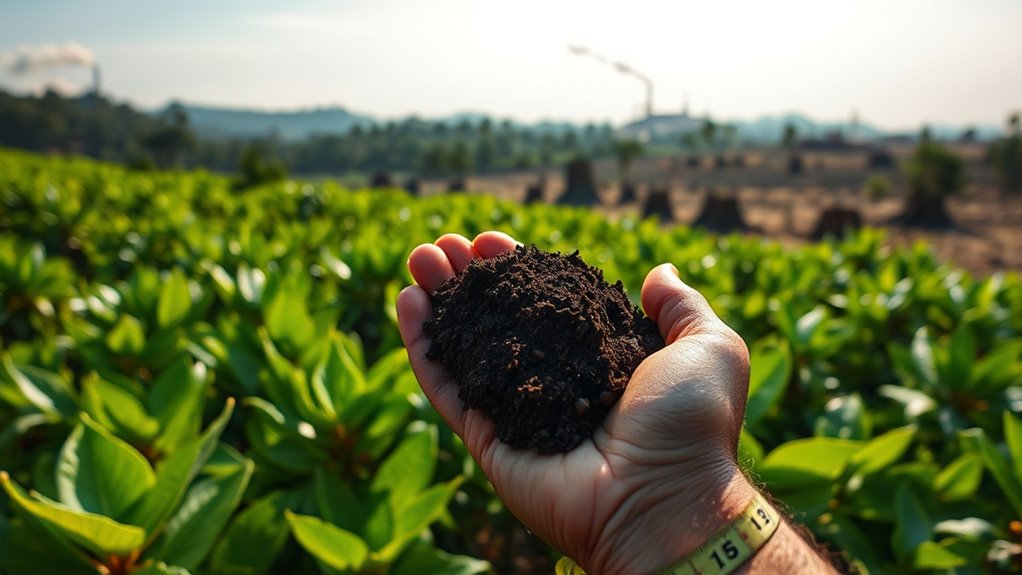
Calculating the carbon footprint of coffee production reveals the significant environmental impact associated with your daily cup. Each cup of coffee you enjoy can produce up to 50 grams of CO2, not including packaging emissions.
The entire process, from cultivation to transportation, contributes to this carbon output, making it essential for you to reflect on every stage. Unsustainable practices, like monocropping and synthetic fertilizers, heighten carbon emissions and lead to soil degradation.
However, some coffee producers are adopting sustainable practices, such as shade-grown coffee and organic farming, which can help reduce the carbon footprint.
Promoting Environmentally Conscious Choices
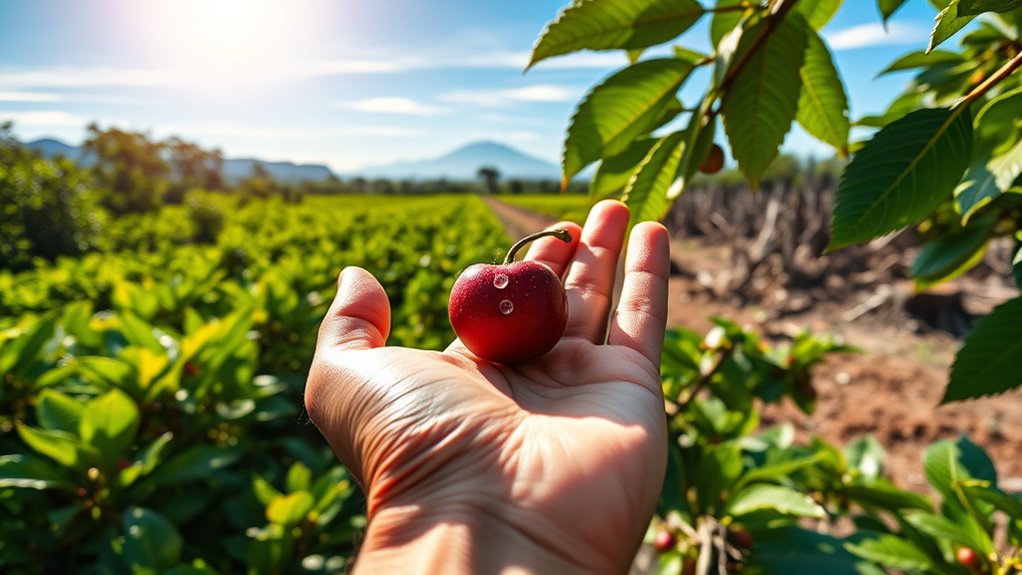
As you savor your daily cup of coffee, consider how your choices can profoundly impact the environment.
By making a few conscious decisions, you can promote sustainability and protect ecosystems.
- Choose organic, shade-grown coffee to reduce pesticide use and support biodiversity.
- Advocate for direct trade practices to guarantee fair wages for farmers and promote environmentally sustainable coffee production.
- Bring a personal reusable cup to coffee shops to save trees and cut down on non-recyclable cup waste—around 50 billion are discarded annually in the U.S.
- Compost your coffee grounds to return nutrients to the soil and responsibly manage waste.
These simple actions can greatly enhance your coffee experience while nurturing the planet. Additionally, consider incorporating essential oils into your daily routine for added benefits, such as improved mood and relaxation.
Future Outlook and Sustainable Practices

The future of coffee production relies on our ability to adopt sustainable practices that can alleviate the impacts of climate change.
You can play a role in helping farmers by supporting shade-grown coffee, which promotes biodiversity and enhances soil fertility. By choosing products from direct trade partnerships, you help guarantee fair wages for smallholder farmers, improving their economic resilience.
Implementing waste management practices, like using compostable coffee cups, can greatly reduce coffee’s environmental footprint.
Collaboration among farmers, organizations, and consumers is essential for developing innovative solutions that enhance production efficiency while fostering environmental stewardship.
Together, we can work towards a sustainable future for coffee, ensuring that it remains a cherished beverage without compromising our planet.
Frequently Asked Questions
What Is the Environmental Impact of Coffee Maker?
When you think about the environmental impact of coffee makers, consider their energy consumption.
If you’re using a microwave, you’re wasting energy compared to a plug-in kettle. You also generate waste from coffee brewing, especially if you’re using non-recyclable cups.
Each cup can produce significant CO2 emissions, and the water usage throughout the supply chain is considerable.
What Are the Environmental Factors Affecting Coffee?
Did you know that for every cup of coffee you drink, about one square inch of rainforest gets destroyed?
Various environmental factors affect coffee, including deforestation, climate change, and soil degradation. When rainforests are cleared for plantations, biodiversity declines, and habitats are lost.
Additionally, fluctuating temperatures and erratic rainfall impact crop yields, making coffee production less sustainable. These challenges threaten both the coffee supply and the ecosystems that support it.
What Is the Environmental Footprint of a Cup of Coffee?
When you sip a cup of coffee, you’re also contributing to its environmental footprint. Each cup requires about 39 gallons of water and generates up to 50 grams of CO2 emissions.
You’re indirectly linked to deforestation, as coffee farming clears land, destroying rainforests. Additionally, the fertilizers used can pollute local waters.
What Is the Biggest Issue Facing Coffee Production?
You’ll find that the biggest issue facing coffee production is the challenge of maintaining sustainable practices.
As demand increases, farmers often resort to methods that harm ecosystems, like monocropping and excessive pesticide use. You’ll notice that this leads to soil degradation and reduced biodiversity.
Additionally, climate change is making it harder to grow coffee in traditional regions, threatening both the quality of the beans and the livelihoods of those who depend on them.
Conclusion
To sum up, coffee production greatly impacts our environment, from deforestation to water pollution. Did you know that it takes about 1,200 liters of water to produce just one kilogram of coffee? That’s about 2,500 cups! By choosing sustainably sourced coffee and supporting eco-friendly practices, you can help reduce this footprint. Every small change counts, so next time you enjoy your brew, remember the difference you can make for our planet.
